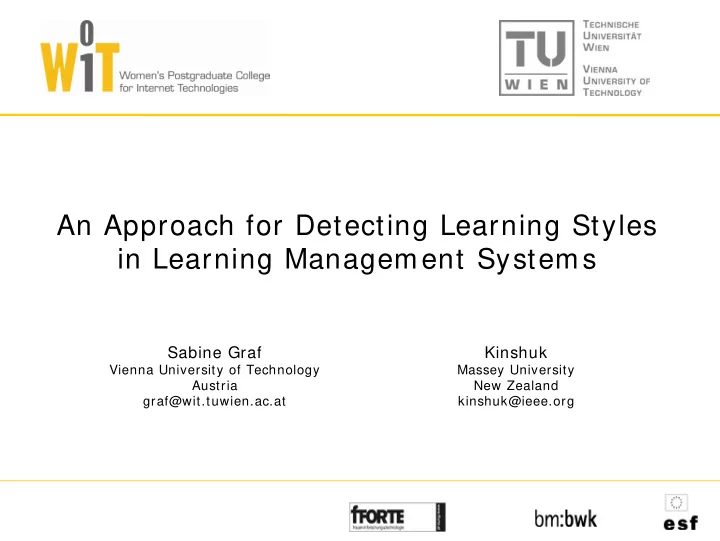

An Approach for Detecting Learning Styles in Learning Management Systems Sabine Graf Kinshuk Vienna University of Technology Massey University Austria New Zealand graf@wit.tuwien.ac.at kinshuk@ieee.org
Motivation and Aim � Learning Management Systems (LMS) are commonly used but they provide only little and in the most cases no adaptivity � Learners have different needs � Incorporating these needs increase the learning progress, leads to better performance, and makes learning easier � Requirement for adaptivity: needs have to be known first � Comprehensive questionnaires � Identification from the behavior of students during a course Aim: Developed an approach that identifies learning styles according to the behavior of students in LMS � Identify patterns of behavior � Implemented a tool that extracts data from LMS database and calculates the learning styles 2
Felder-Silverman Learning Style Model � Richard M. Felder and Linda K. Silverman, 1988 � Each learner has a preference on each of the four dimensions � Dimensions: � Active – Reflective learning by doing – learning by thinking things through learning by discussing & group work – work alone � Sensing – Intuitive concrete material – abstract material more practical – more innovative and creative patient / not patient with details standard procedures – challenges � Visual – Verbal learning from pictures – learning from words � Sequential – Global learn in linear steps – learn in large leaps good in using partial knowledge – need „big picture“ interested in details – interested in the overview 3
Patterns of Behavior � Felder and Silverman describe how learners with specific preferences act in learning situations � Based on commonly used features in LMS such as content objects, forum, chat, self-assessment (SA), exercises, and examples Active/Reflective Sensing/Intuitive Visual/Verbal Sequential/Global Visits_forum (act) Correct_facts/concepts (sen) Visits_forum (ver) Correct_detail/overview (seq) Postings_forum (act) Revisions_marked tests (sen) Postings_forum (ver) Performance_marked tests (seq) Visits_chat (act) Revisions_SA tests (sen) Visits_chat (ver) Performance_SA tests (seq) Postings_chat (act) Duration_marked tests (sen) Postings_chat (ver) Visits_outline (glo) Visits_exercise (act) Duration_SA tests (sen) Time_graphics (vis) Time_outline (glo) Time_exercises (act) Visits_exercises (int) Correct_graphics (vis) Skips_learning objects (glo) Time_examples (ref) Time_exercises (int) Visits_overview page (glo) Time_content objects (ref) Visits_SA tests (sen) Time_overview page (glo) Visits_examples (sen) Time_examples (sen) 4
Tool Architecture � Tool can be applied for LMS in general � Each LMS has a different database schema � Maybe not all features are used or data for patterns can be tracked � Architecture: 5
Data Extraction Component � Global schema � Top-down approach: required information (patterns) act as basis � Each table includes data representing one pattern � Extraction should be as simple as possible � use event-based way in which data are stored in LMS � Cumulation of data is done automatically 6
Calculation Component � Calculate ordered data from raw data e.g. User 1: 94 % time spend � high � sensing � + 1 � determine thresholds based on values from literature � 3-item scale (+ 1, 0, -1) � provide recommendation and teachers can change thresholds � Calculate learning styles from ordered data � Based on approach of questionnaire (ILS) � Summing up the values relevant for the dimension � Result is converted to 3-item scale (e.g. sensing – balanced – intuitive) 7
Conclusion and Future Work � Developed an approach and implemented a tool for identifying learning style based on the behavior of students in LMS � Identified general patterns of behavior � Developed a tool that extracted required data from LMS database and calculated learning styles � Future work � Evaluate the tool (comparing results of the tool with results of ILS) � Improve calculation approach (AI approach) 8
Recommend
More recommend